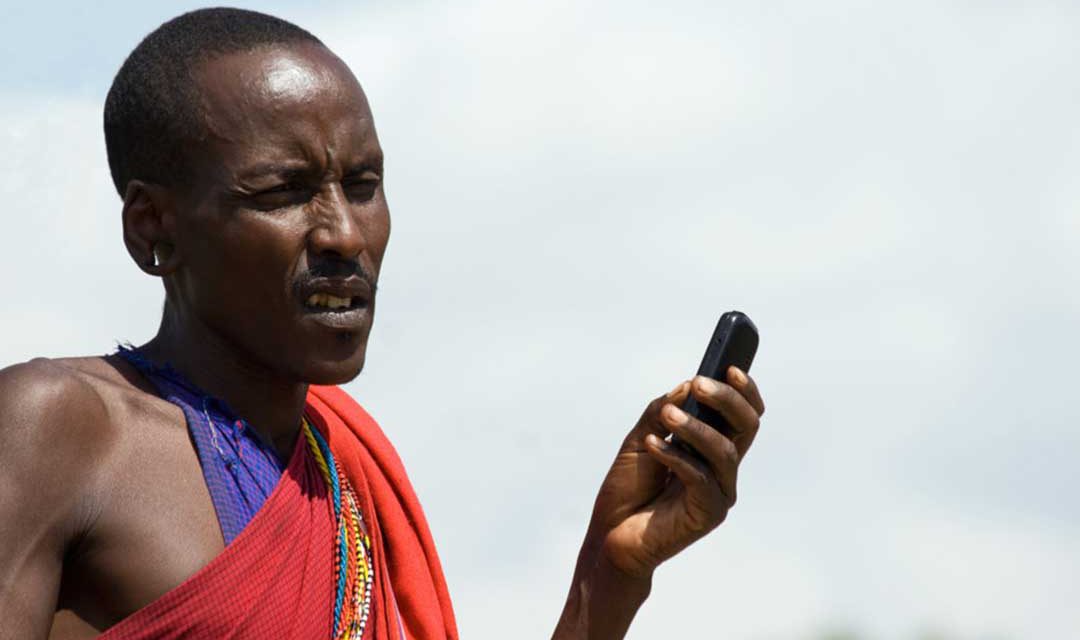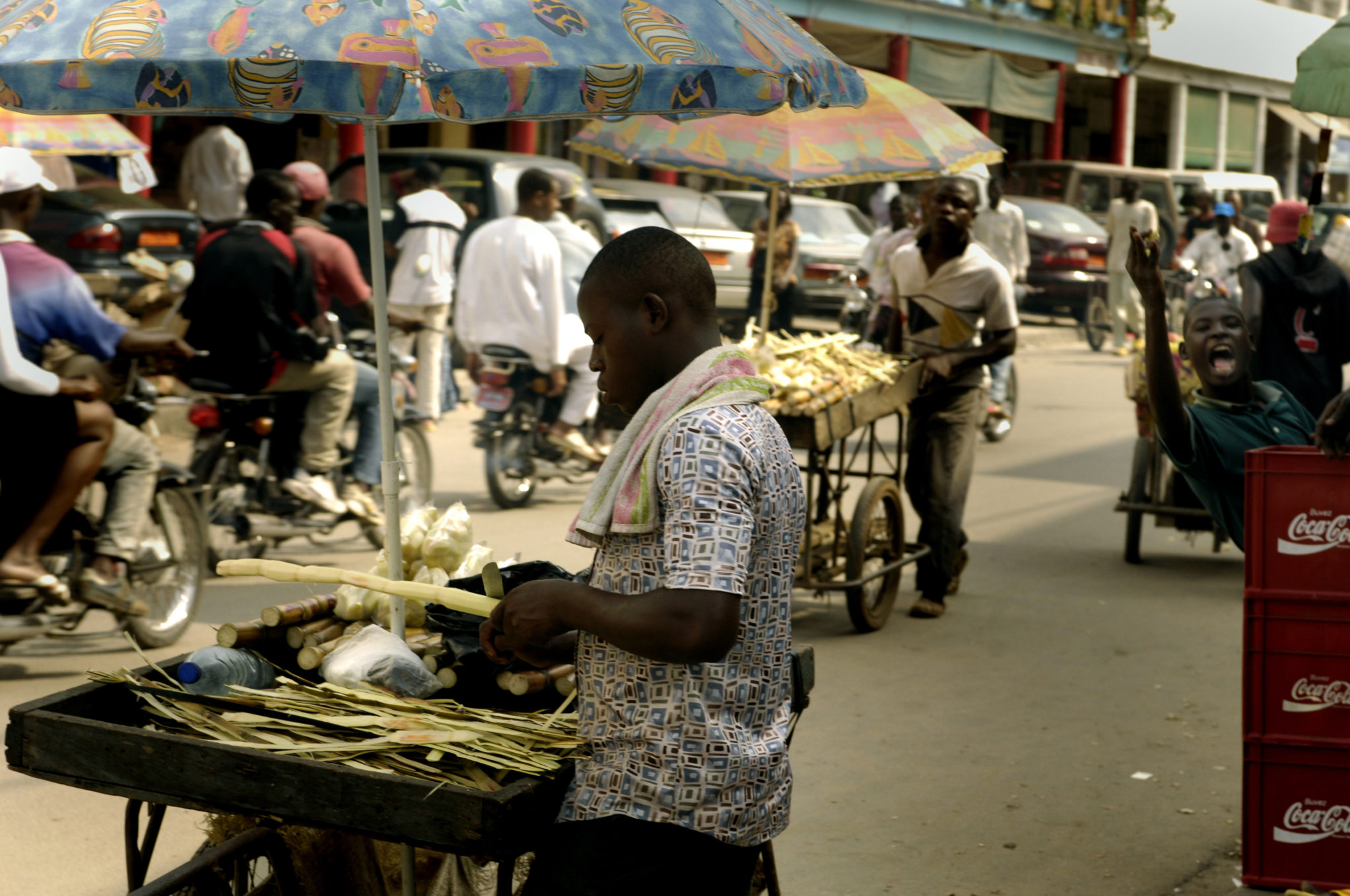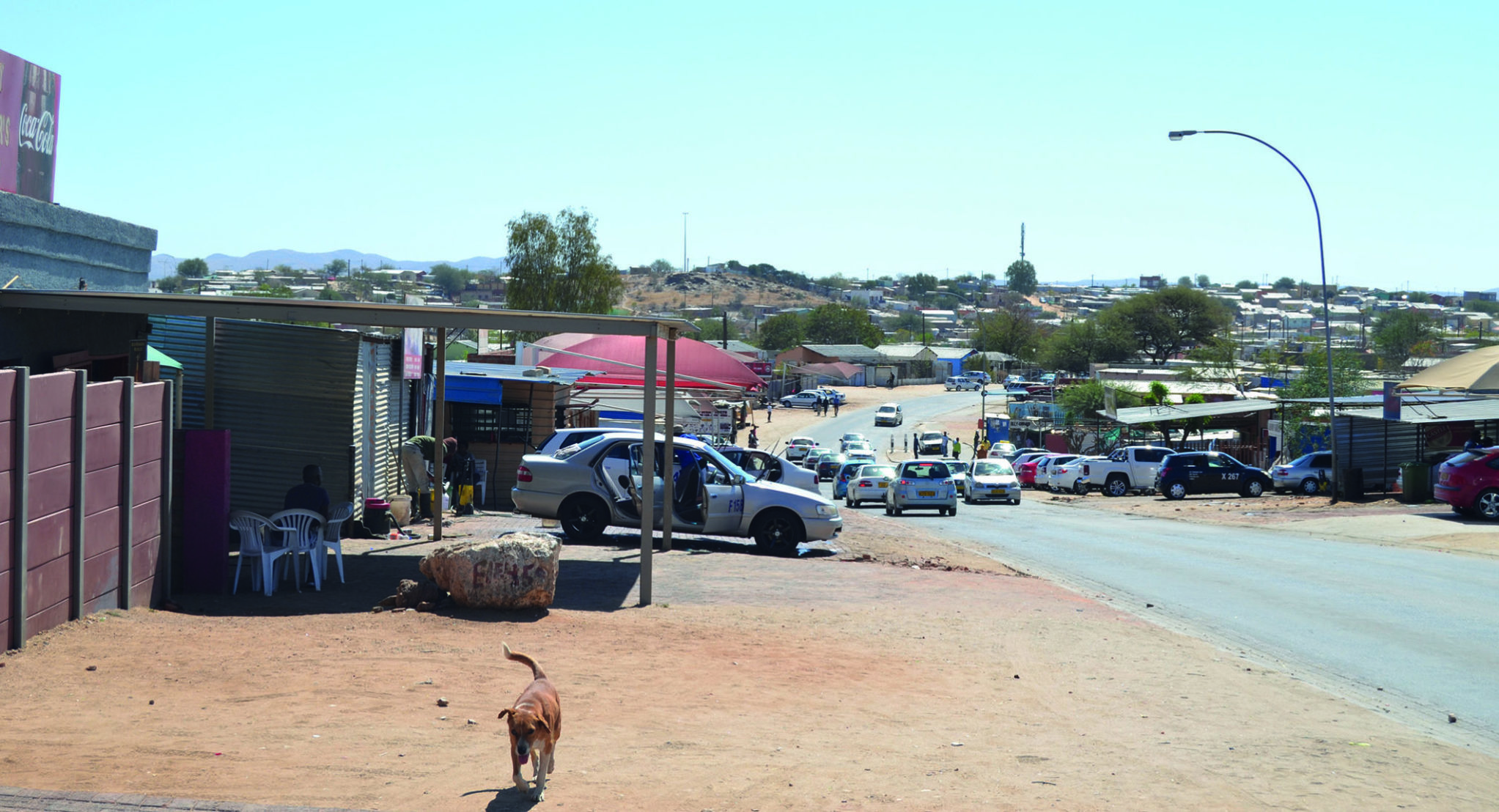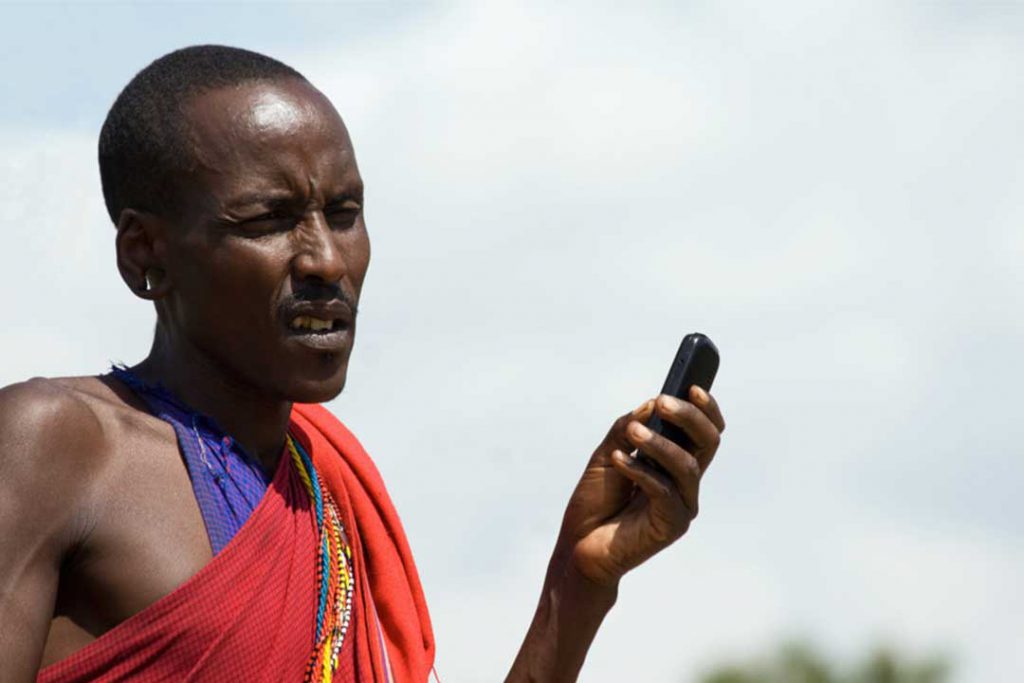
Native Masai with Cellphone in Masai Mara National Park, Kenya
Mobile money helps Africa’s informal operators to conduct safe transactions – and keep their money safe
On any corner in Nairobi on any given day, the future of African commerce can be seen in action. From the most basic of feature phones, right up to sophisticated smartphones, M-Pesa, a mobile money service, has revolutionised how people pay each other money and do their daily financial transactions.
Since M-Pesa was pioneered by Safaricom – Kenya’s largest mobile operator with some 70% market share – it has expanded to 29.5 million active customers in 10 markets. They did a whopping six billion mobile money transactions in 2016, according to parent Vodafone, which recently sold Safaricom to its South Africa-based subsidiary Vodacom. In 2015, M-Pesa processed $28 billion in transactions, about 44% of the country’s nearly $65 billion GDP.
Some 25 million Kenyans use the service. “Mobile money is now achieving mass-market adoption in all corners of sub-Saharan Africa, enabling millions of people to access financial services for the first time and contributing to economic growth and social development,” says Mats Granryd, director general of the GSM Association (GSMA), headquartered in London.
M-Pesa is the leading mobile money service in the world, and Africa had over 140 mobile money services in 39 countries at the end of 2016, according to a July 2017 GSM Association report on mobile money in sub-Saharan Africa. That means that Africa has over half of the world’s 277 mobile money systems.
In seven markets in the region, more than 40% of adults are active mobile money users, according to the GSMA. These are Gabon, Ghana, Kenya, Namibia, Tanzania, Uganda and Zimbabwe.
Africa is seeing “encouraging innovation” beyond the introduction of 3G and 4G cellphone technologies, which enabled faster and larger data transfers, says Granryd. “One is, of course, mobile money. Even though it’s 10 years old, there are applications on top such as solar power, using the pay-as-you-go model,” he told Africa in Fact.
“Mobile operators in the region today are using mobile money to create new financial ecosystems that can deliver a range of innovative new services across multiple industry sectors, including utilities and agriculture.”
Companies like M-Kopa and Koko Networks have used M-Pesa to allow people to buy solar equipment and cooking gas. M-Kopa lets people use M-Pesa to pay off a solar kit – which includes a battery with built-in SIM card, solar panel, two hanging LED lights, a torch and rechargeable radio – over the course of a year, after which they own it outright. The solar kit “is a phenomenal way of combining several disciplines into one service,” Granryd says.
It allows users to charge a phone, to keep in touch via radio, and its lights enable children to study at night. In future, it could also allow refrigeration or TV use. “The registration of births, deaths, and land is another example of where technology can play a major role,” he adds.
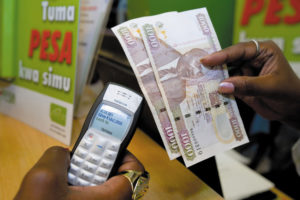
The potential for mobile money to draw in the previously unbanked and the informal economy into the greater financial economy is remarkable. “One need only point to Kenya as evidence for the impact of digital inclusion,” says Arthur Goldstuck, MD of researchers World Wide Worx and a seasoned technology journalist.
“Before 2009, less than 10% of the population had any form of financial instrument, and cash was the only economy for more than 90% of the population.”
But the arrival of mobile money means that 75% of the Kenyan population now has a financial instrument that enables both transactions and enterprise development, says Goldstuck. “For instance, taxi drivers in Kenya today require payment via mobile money and no longer carry cash. The same applies to small, informal businesses such as roadside stalls, which are suddenly able to use mobile money, not only as a sales vehicle but also as a way to store money.”
Sub-Saharan Africa had 420 million unique mobile subscribers at the end of 2016, or 43% of the population. The GSMA projects this will increase to 535 million in 2020, or 50% of the population. This makes the continent the fastest growing region in the world over this period.
“Mobile is also a vital tool in delivering digital and financial inclusion in sub-Saharan Africa,” adds Granryd. Some 270 million people in the region surf the internet on their mobiles, while some 277 million had registered mobile money accounts at the end of 2016. There are also 1.5 million registered mobile money agents.
Mobile money users have historically been concentrated in east Africa, home to major mobile money markets such as Kenya, Tanzania and Uganda. “However, the latest data suggests that user growth is now being driven by other markets in the region, notably west Africa. Almost 29% of active mobile money accounts in sub-Saharan Africa are now based in west Africa, as compared to just 8% five years earlier, says Granryd.
As of 2013, about 85% of global transactions still involved cash, according to Mastercard. Yet as counter-intuitive as it seems, cash is more expensive to use than electronic currency. For many people in Africa, drawing money from an ATM involves travelling considerable distances and spending unproductive hours in transit. And getting cash at ATMs makes them more susceptible to crime.
In South Africa for instance, using cash in 2015 cost consumers R23 billion, or 0.52% of the country’s GDP, according to a MasterCard study released at the World Economic Forum on Africa in May this year.
“Cash is the enemy of financial inclusion and of the poor,” says Mark Elliott, division president of MasterCard, southern Africa. He argues that the burden of the cost falls on the lower-income groups, and therefore prohibits financial inclusion. The cost of cash is demonstrably higher for lower-income people, who often live at some distance from city centres, ATMs, and supermarket chains.
Some 77% of adults in South Africa had bank accounts in 2016, up from 63% in 2011, according to the FinScope South Africa 2016 Survey on Financial Inclusion report. Despite this, people still use cash in 52% of consumer transactions – less than the 85% global average but still high. “This suggests that being formally banked may not be enough of a driver for consumers to move away from cash,” says Elliot.
Banks also charge steep fees for accepting cash as a deposit. For them, digital currency is cheaper, partly because it requires fewer armed security services. Goldstuck points out these are examples of how digital currency formalises the informal economy. “It all comes down to financial inclusion, and clearly financial inclusion is one of the engines of a developing economy.”
One unexpected benefit of digital currency is that it not only enables people to save, but also to keep their money safe. Being able to safely store money is crucial for businesses everywhere, and this includes informal businesses. “Many people can now have a bank account, which was unthinkable a decade ago,” says Goldstuck. “That is inspiring a lot of people to start small businesses.”
Financial inclusion in this sense also enables new business opportunities. People who want to make opportunities for themselves in the informal economic space can become resellers of a wide range of digital products, ranging from airtime to music to electricity, Goldstuck adds.
For users in Africa, digital cash is a solution to a particular problem – the ability to access money. “Fifty percent of smallholder farmers are women,” says Shamina Singh, the president of MasterCard’s Centre for Inclusive Growth in New York. “They have to stay on the land to do the actual work. So to go negotiate a price for their crop is unproductive, as every step you’re away from the farm, you aren’t working on your farm. But if you can do it via mobile, your productivity as a farmer increases in leaps and bounds.” It also allows smallholders to spend more time with their families, she adds.
Meanwhile, MasterCard has found a smart way to get rid of point-of-sale (PoS) terminals using a technology that is already ubiquitous, the QR code. The company demonstrated the potential at the Mobile World Congress in Barcelona earlier this year.
MasterCard offered two contrasting demonstrations, one a sophisticated robot waiter with a touchscreen and voice assistant that allows customers to order and pay for their meals. The other is a low-tech rickshaw driver’s payment mechanism that works with feature phones and smartphones. Customers with smartphones scan the QR code and effect the transaction directly to the driver’s mobile wallet. Those with feature phones can use a short code to SMS the fee. Singh says if the transaction is between banks, it can be settled in seconds.
One very good example of innovative thinking by a bank is SnapScan, which supplies its retailers with a large QR code in a Perspex stand which customers can scan, using the app; after that, they only have to fill in the amount to pay for a purchase. A new version of the Standard Bank-owned app works with some chain stores, while people can also use it to pay for TV licences or subscriptions. It can even be used to pay for parking in some areas of Cape Town.
“SnapScan is a good example of how digital solutions have had a significant impact on the way small businesses are able to trade,” says Arno von Helden, the head of forex and trade product for personal and business banking at Standard Bank South Africa’s Global Markets. “Traditionally, merchants either had to have a PoS device to accept credit and debit cards, or they had to accept cash with the associated costs and risks. With SnapScan, small businesses can now accept payments for goods and services through the use of a QR code, completely removing the need for a PoS device or cash.”
Moving from cash to digital currency has several advantages. Small businesses are increasingly moving into the digital transactions space because it offers advantages in security, convenience and cost, von Helden says. Additionally, those transaction services are available 24 hours a day, and remove some of the “hassle factor” associated with cash transactions, including the need to visit a branch or access an ATM device for cash deposits and withdrawals.
The success of mobile money is partly due to the fact that digital wallets provide people with access to payment mechanisms directly from their mobile phones without having to open up a traditional bank account, he adds.
The power of digital money is best illustrated by M-Pesa itself, which started as a clever idea in Kenya and became the most successful money service in the world, in terms of active users and transactions. Accounting as it now does for 44% of the country’s GDP, there are real fears that M-Pesa might impact inflation, or cause serious economic problems if the system ever went offline. Nothing defines innovation and becoming part of the formal economy better than that.
Toby Shapshak is editor-in-chief and publisher of Stuff and a contributor to Forbes. His TED talk on innovation in Africa has over 1.4 million views, and he has been featured in the New York Times.

